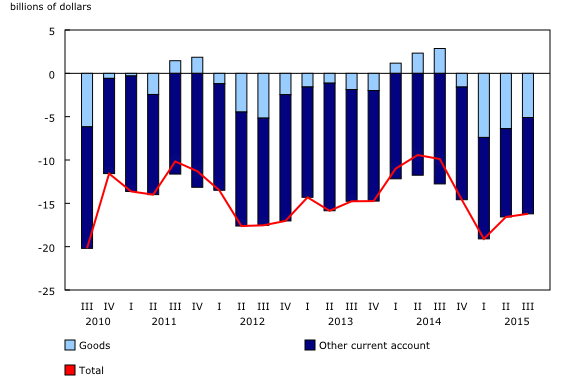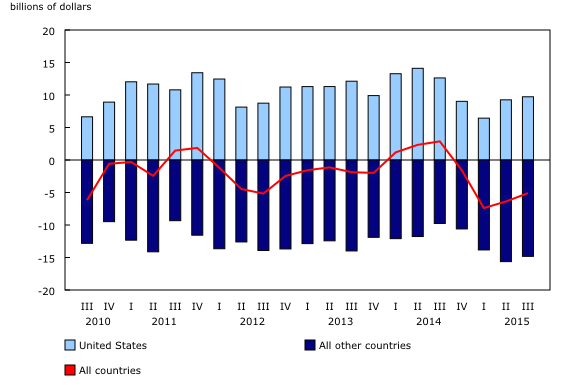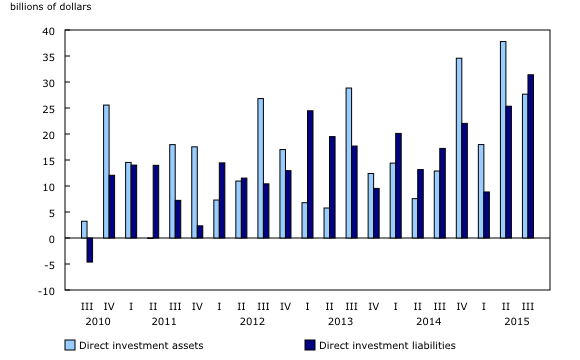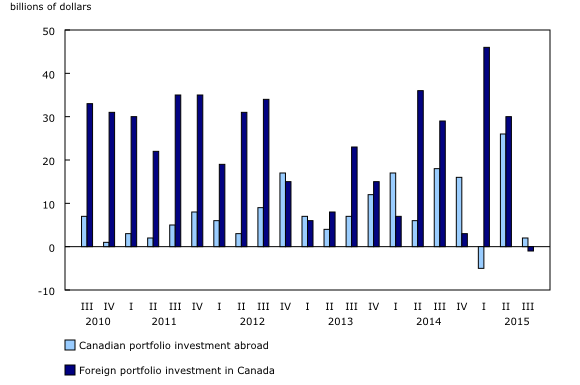Canada's balance of international payments, third quarter 2015
Archived Content
Information identified as archived is provided for reference, research or recordkeeping purposes. It is not subject to the Government of Canada Web Standards and has not been altered or updated since it was archived. Please "contact us" to request a format other than those available.
Released: 2015-11-30
-$16.2 billion
Third quarter 2015
Canada's current account deficit (on a seasonally adjusted basis) narrowed $0.4 billion in the third quarter to $16.2 billion. A lower deficit on trade in goods was partially offset by a higher deficit on cross-border investment income flows.
In the financial account (unadjusted for seasonal variation), transactions in direct investment liabilities, largely foreign acquisitions of Canadian companies, led the inflows of funds into the economy.
Current account
Overall deficit on trade in goods narrows
The deficit on international transactions in goods was reduced by $1.3 billion in the third quarter to $5.1 billion. After a large increase in the first quarter, Canada's trade in goods deficit with the rest of the world has narrowed for a second straight quarter.
The goods surplus with the United States rose by $0.5 billion despite lower exports of crude petroleum. The trade deficit with all other countries was down by $0.8 billion. One of the main contributors was trade with India, where the goods surplus expanded by $0.6 billion on higher exports.
Total exports of goods advanced $4.7 billion to $134.2 billion in the third quarter. The largest gains were recorded in consumer goods and in motor vehicles and parts. Consumer goods rose $2.3 billion, mostly on higher volumes of miscellaneous goods and supplies and of pharmaceutical products. Motor vehicles and parts increased $2.2 billion, led by higher prices and volumes of passenger cars exported. Aircraft and other transportation equipment rose $0.5 billion, mostly on higher prices. Moderating these gains was a $2.2 billion decline in exports of energy products, with lower crude petroleum prices accounting for nearly all the reduction.
Total imports of goods were up $3.4 billion to $139.3 billion in the third quarter. Imports of consumer goods increased $1.1 billion, on higher prices. Electronic and electric equipment and parts rose by $1.0 billion, led by larger volumes of communications and audio and video equipment. Imports of basic and industrial chemical, plastic and rubber products increased $0.7 billion, also on higher volumes. Motor vehicles and parts were up $0.4 billion, as a $1.1 billion increase in parts was moderated by a reduction in passenger cars imported.
Trade in services deficit narrows marginally
The overall deficit on international trade in services narrowed $0.1 billion to $5.6 billion in the third quarter.
The travel deficit was down $0.1 billion to $4.0 billion. Non-residents increased their spending in Canada as more travellers entered the country during the quarter, which generated higher receipts. However, payments edged down, reflecting a decline in spending by Canadian travellers in the United States, moderated by increased spending in non-US countries.
Changes in the transportation services deficit and the commercial services surplus were marginal and offset each other in the quarter.
Deficits on investment income and secondary income expand
The investment income deficit increased $0.6 billion to $4.2 billion in the third quarter. Profits earned by foreign direct investors on their Canadian assets were up $0.2 billion, while those earned by Canadian direct investors on their assets abroad were largely unchanged. Higher interest payments on other investment liabilities mainly accounted for the rest of the increase. For portfolio investment, income on both assets and liabilities was up by the same amount during the quarter.
The deficit in secondary income rose by $0.5 billion to $0.8 billion, as payments of government transfers increased following a weak second quarter.
Financial account
Transactions in direct investment remain strong
Transactions in direct investment liabilities, covering foreign parents' claims on Canadian affiliates as well as Canadian parents' debt held by their foreign affiliates totalled $31.4 billion in the third quarter. This was the highest such investment since the fourth quarter of 2007. The bulk of this investment was in the form of equity. Notably, foreign mergers and acquisitions in Canada were the highest in almost eight years at $18.4 billion.
On the asset side, direct investment reached $27.7 billion in the third quarter, following a record outflow of funds of $37.8 billion in the second quarter. Direct investment assets include Canadian parents' claims on their foreign affiliates as well as foreign parents debt held by their Canadian affiliates. The activity in the third quarter was led by outward cross-border mergers and acquisitions, which remained strong at $20.7 billion. Since the beginning of the year, Canadian mergers and acquisitions abroad have totalled $48.7 billion, already exceeding the highest annual level ever recorded.
Foreign holdings of Canadian securities decline for the first time since the end of 2008
Foreign investors reduced their holdings of Canadian securities by $0.9 billion in the third quarter compared with a $30.1 billion investment in the previous quarter. Non-residents continued to invest in Canadian debt securities, but at a slower pace. However, they reduced their holdings of equities in the quarter. This was the first divestment in Canadian securities since the fourth quarter of 2008. The Canadian dollar depreciated US 5.1 cents against the US dollar in the quarter.
The $9.2 billion reduction in foreign holdings of Canadian equities was the largest such divestment since the first quarter of 2013. This reduction was related to cross-border mergers and acquisitions activity. Foreign portfolio investors rendered Canadian shares to foreign direct investors in July as a result of this activity.
Foreign investors acquired $12.8 billion of Canadian bonds in the quarter, all corporate bonds from both private corporations and government business enterprises. Foreign holdings of Canadian government bonds were down, as acquisitions of federal government bonds were more than offset by a divestment in provincial government bonds. At the same time, foreign investors withdrew $4.4 billion of funds from the Canadian money market, mainly provincial government and private corporate paper.
Canadian investment in foreign securities slows
Canadian investment in foreign securities slowed to $2.1 billion in the third quarter, following a $25.6 billion acquisition in the second quarter. Most of the investment activity was in foreign bonds as Canadian investors sold money market instruments, while holdings of foreign equities were largely unchanged. On a geographical basis, Canadians purchased $15.2 billion of US securities and sold $13.1 billion of non-US foreign securities in the quarter.
The other investment category generates an inflow of funds
Transactions in the other investment category of the financial account generated a net inflow of funds of $10.7 billion in the third quarter. This activity mainly reflected a reduction in currency and deposit assets held abroad.
Note to readers
Revisions
This release incorporates revisions back to 1981 as part of the 2015 comprehensive revision of the Canadian System of Macroeconomic Accounts (CSMA). Revisions to the balance of payments account reflect statistical, classification, conceptual and presentational changes. This exercise was conducted to strengthen the overall quality of the international accounts and to introduce new concepts and classifications as recommended by updated international standards.
For more information on revisions applied to the balance of payments as part of the 2015 comprehensive revision of the CSMA, see Revisions to Canada's Balance of International Payments.
Definitions
The balance of international payments covers all economic transactions between Canadian residents and non-residents in three accounts: the current account, the capital account and the financial account.
The current account covers transactions in goods, services, compensation of employees, investment income and secondary income (current transfers).
The current account data in this release are seasonally adjusted. For information on seasonal adjustment, see Seasonally adjusted data – Frequently asked questions.
The capital account covers capital transfers and transactions in non-produced non-financial assets.
The financial account covers transactions in financial assets and liabilities.
In principle, a net lending (+) / net borrowing (-) derived from the sum of the current and capital accounts corresponds to a net lending (+) / net borrowing (-) derived from the financial account. In practice, as data are compiled from multiple sources, this is rarely the case and gives rise to measurement error. The discrepancy (net errors and omissions) is the unobserved net inflow or outflow.
For more information on the balance of payments, consult the Frequently asked questions section in the System of macroeconomic accounts module of our website. The module also presents the most recent balance of payments statistics.
Real-time CANSIM table
Real-time CANSIM table 376-8105 will be updated on December 7. For more information, consult the document Real-time CANSIM tables.
Next release
Balance of international payments data for the fourth quarter of 2015 will be released on February 29, 2016.
Products
The document "Revisions to Canada's Balance of International Payments," which is part of Latest Developments in the Canadian Economic Accounts (13-605-X), is now available from the Browse by key resource module of our website under Publications.
Contact information
For more information, contact us (toll-free 1-800-263-1136; 514-283-8300; STATCAN.infostats-infostats.STATCAN@canada.ca).
To enquire about the concepts, methods or data quality of this release, contact Denis Caron (613-808-2278; denis.caron@canada.ca), International Accounts and Trade Division.
- Date modified:





